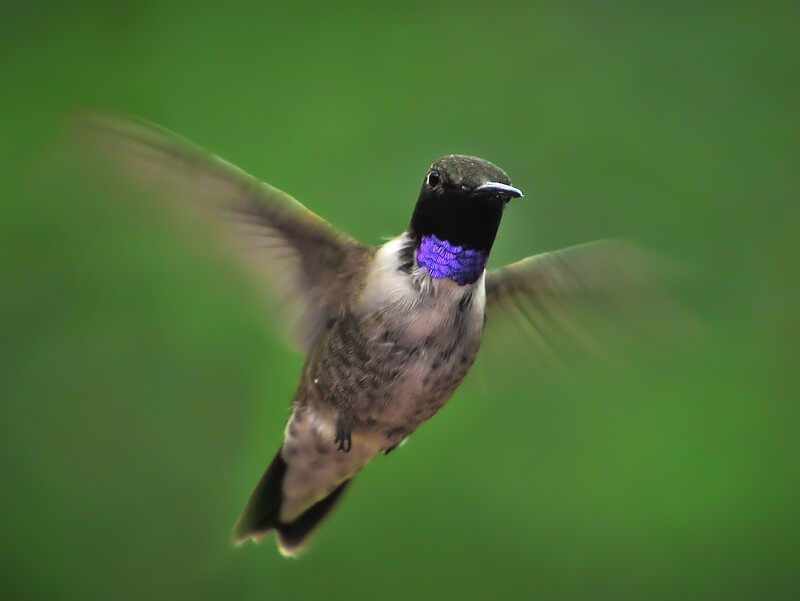Hummingbirds are some of the most beloved birds in Florida. These tiny, colorful creatures have a special place in the hearts of many Floridians. Not only are they beautiful to look at, but they also play an important role in the state’s ecology. From the Everglades to the beaches, hummingbirds can be found in many different parts of the state. They are attracted to the warm climate and the abundance of flowers and plants that can be found in Florida. The geography of the state also plays a role in how hummingbirds interact with their environment. Different species of hummingbirds can be found in different parts of the state, depending on the type of habitat they prefer. In this article, we will explore the different types of hummingbirds found in Florida and how they interact with the state’s geography.
Hummingbirds in Florida
Read on to learn more about the 10 hummingbirds that visit Florida.
Allen’s Hummingbird

- Selasphorus sasin
- Size: 3.5″ (9 cm)
Identification and Color: A deep orange and green color overall. Females are bronze-green and paler orange with bronze spots on the throat. Small and stocky at about 3.5 inches in length. Their bill is straight and long.
Habitat and Behavior: Common to the west coast of the United States and Mexico. Prefers somewhat open areas of brushy canyons and coastal forests. Males will show off by flying in wide arcs. Allen’s Hummingbirds will quickly move between flowers and catch some insects from plants.
Diet: Enjoys a diet of insects and nectar. Favors red tube-like flowers like a paintbrush or scarlet sage.
What does Allen’s Hummingbird sound like?
More Allen’s Hummingbird Facts
Anna’s Hummingbird

- Calypte anna
- Size: 4″ (10 cm)
Identification and Color: Growing to only 4 inches in length, Anna’s Hummingbird is on the stocky side. They have a short, straight bill and long tail. Mostly green and grey, but males have iridescent pink around their heads. Both sexes have white on their undersides.
Habitat and Behavior: Found on the west coast year-round. Will visit feeders in gardens or parks. Can be located in open woods or by streams and rivers. They are very fast and can be hard to see while in motion. Will stop and hover over a flower or feeder to eat.
Diet: Anna’s Hummingbird diet consists of nectar and tiny insects.
What does Anna’s Hummingbird sound like?
More Anna’s Hummingbird Facts
Black-chinned Hummingbird

- Archilochus alexandri
- Size: 3.25″ (8.25 cm)
Identification and Color: A small and slender hummingbird. They have a metallic green head and tail that is not shiny. Males have a black throat with an iridescent purple stripe around it. Females have a paler throat. Has a long, black, narrow bill.
Habitat and Behavior: Found in the western United States and Mexico. Found in various areas like river groves, forests, and semi-arid locations. Males will display during the breeding season by diving steeply in the air. They will dart around flowers and eat insects on vegetation or in the air.
Diet: The Black-chinned Hummingbird enjoys nectar from flowers or hummingbird feeders. Will also eat tiny insects.
What does a Black-chinned Hummingbird sound like?
More Black-chinned Hummingbird Facts
Broad-billed Hummingbird
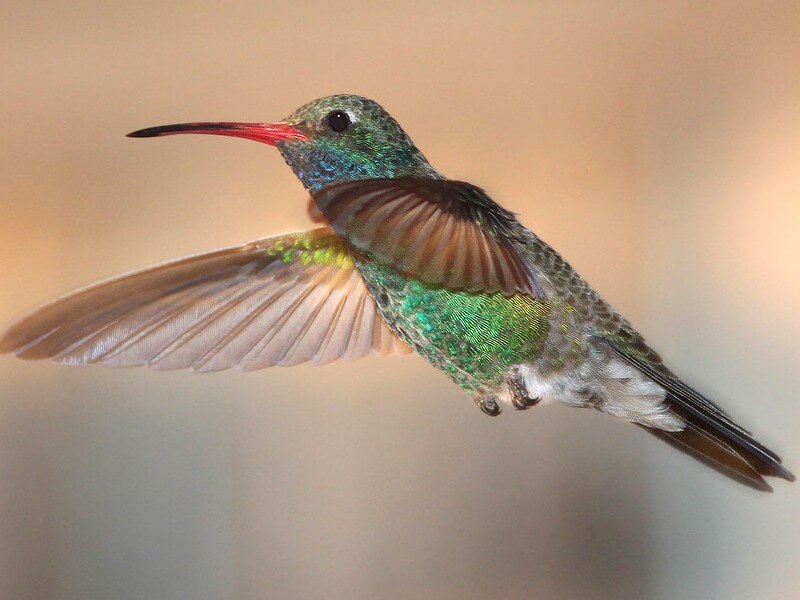
- Cynanthus latirostris
- Size: 4″ (10 cm)
Identification and Color: Males are shimmery green and blue with a blue throat. Females are yellowish green on top with gray underparts and white marks above the eye. Males and females have straight long bills, males’ bills are red with a black tip, and females’ are black.
Habitat and Behavior: Present in the southern United States and Mexico. Usually stays at high elevations in streams, woodlands, and mountainous areas. Males will sometimes display in small groups and fly back and forth. Will drink nectar by inserting their bills into the flower.
Diet: Nectar and insects make up the Broad-billed Hummingbirds diet. Prefers red or orange tube-like flowers.
What Does a Broad-billed Hummingbird sound like?
More Broad-billed Hummingbird Facts
Broad-tailed Hummingbird
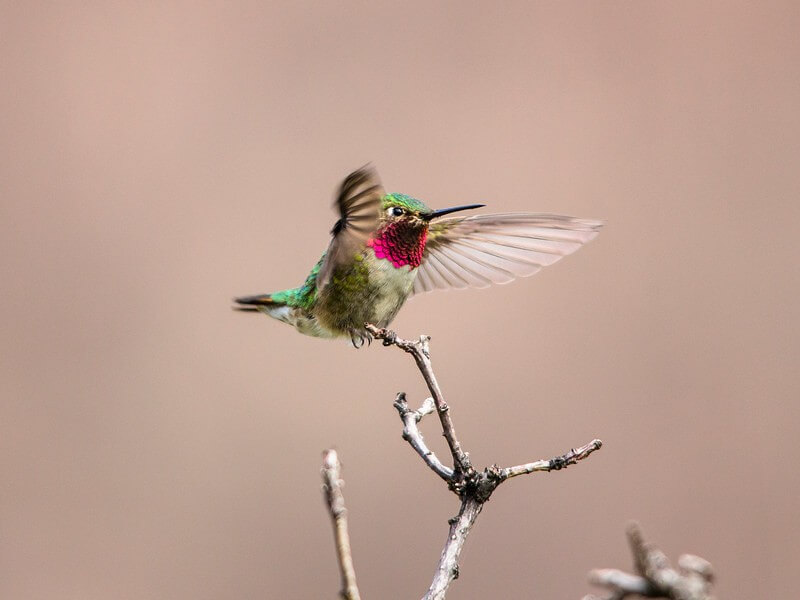
- Selasphorus platycercus
- Size: 3.5″ (9 cm)
Identification and Color: The broad-tailed hummingbird has a big head, slender body, and long straight bill. Iridescent green on top with a white chest and underparts. Males have a bright red throat patch. Females have green spots on the throat and a light ring around their eyes.
Habitat and Behavior: Found in the west, they like higher elevation areas. Including mountainous meadows, forests, and shrubby places. Males will fly high in the sky and dive steeply back down. A metallic sound can be heard from the wings.
Diet: Nectar and insects. Red tube-like flowers are preferred, and sometimes tiny insects.
What does a Broad-tailed Hummingbird sound like?
More Broad-tailed Hummingbird Facts
Buff-bellied Hummingbird

- Amazilia yucatanensis
- Size: 4″ (10 cm)
Identification and Color: A larger hummingbird with a long tail, bill, and wings. The bill is red with a black tip at the end. They have a brassy green top, iridescent blue, and green throat with lighter underparts. Brown and black tail feathers. Males and females are similarly colored.
Habitat and Behavior: Can be seen in southern Texas and Louisiana in the United States. Prefers lowlands of forest thickets and brushland. May chase away smaller hummingbirds from food, such as sugar-water mixed feeders.
Diet: Will eat nectar from feeders and flowers. Flowers, red salvia, and Turk’s cap are preferred. They will also eat small insects.
What Does a Buff-bellied Hummingbird sound like?
More Buff-bellied Hummingbird Facts
Calliope Hummingbird
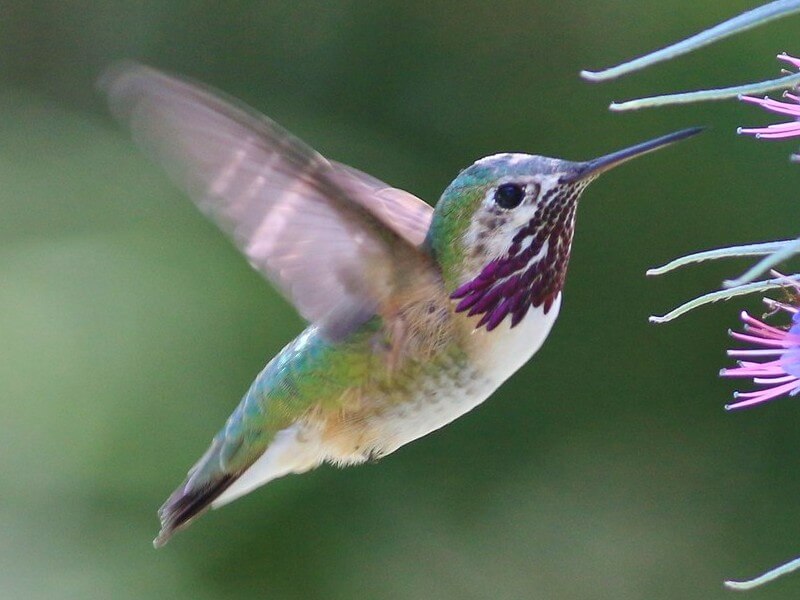
- Selasphorus calliope
- Size: 3″ (8 cm)
Identification and Color: A very small hummingbird between 3 and 3.5 inches in length. Males and females are green-yellow on top and white underparts. Males have magenta-purple lines on their throats. They have short wings, tails, and slender bills.
Habitat and Behavior: Located in the western United States and Mexico. The Calliope Hummingbird likes mountain meadows, thick glades, and canyon areas. Males will display by making dives in the air. These birds will forage low to the ground.
Diet: Will eat tiny insects from the ground. Enjoys nectar from flowers or feeders primarily.
What does a Calliope Hummingbird sound like?
More Calliope Hummingbird Facts
Costa’s Hummingbird
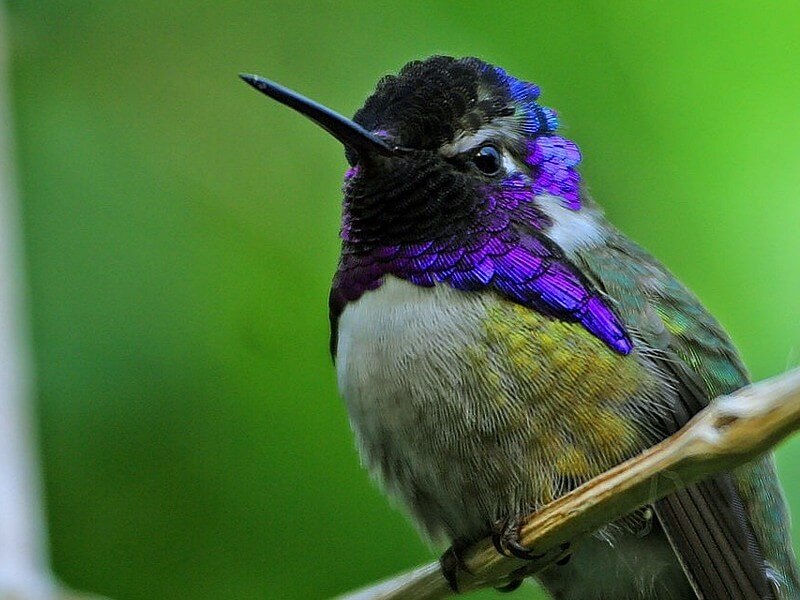
- Calypte costae
- Size: 3.5″ (9 cm)
Identification and Color: Males and females are yellow and green on top, with dark faces and light underparts. Males have an iridescent purple crown and throat. T hey have short tales, short wings, and slender bills. These birds are small and often in a haunced posture.
Habitat and Behavior: Likes western desert habitats, including the desert scrub found in the Mohave and Sonoran deserts. Males will give high-pitched whistles while flying and diving. They will catch and eat insects in midair.
Diet: May eat insects, but the diet is mostly nectar. Will get nectar from desert plants like agave and desert honeysuckle.
What does a Costa’s Hummingbird sound like?
More Costa’s Hummingbird Facts
Ruby-throated Hummingbird

- Archilochus colubris
- Size: 3.5″ (8 cm)
Identification and Color: The Ruby-throated Hummingbird has a brilliant green color on the tops of their heads and bodies and a grey to white underpart. The males have a red throat that can appear dark in poor lighting. A small bird between 2 and 3.5 inches in length. They also have very short wings. A long, slender slightly curved bill.
Habitat and Behavior: In the summer they are found throughout the midwest and the eastern United States but almost all leave for the winter. The Ruby-throated Hummingbird prefers open woodlands, meadows, and gardens. They can fly very fast and will forage from flowers or feeders.
Diet: Mostly nectar from flowers but will eat some small insects.
What does a Ruby-throated Hummingbird sound like?
More Ruby-throated Hummingbird Facts
Rufous Hummingbird

- Selasphorus rufus
- Size: 3″ (7.5 cm)
Identification and Color: A smaller hummingbird with short wings, tapered tail feathers, and a straight bill. Males are bright orange with an iridescent red throat and white underparts. Females are green on top with duller orange colors.
Habitat and Behavior: Commonly breed and migrates to the western United States but may also spend winter months in the southeast. Exceptionally fast flyer and will often chase away other hummingbird species from food. Prefers open areas like yards, gardens, or edges of forests.
Diet: Prefers red tube-like flowers for nectar. It also eats tiny insects like spiders.
What does a Rufous Hummingbird sound like?
More Rufous Hummingbird Facts
Conclusion
Hummingbirds are a unique and fascinating species of bird that are an important part of the local ecosystem and provide a variety of benefits to the environment. While there are some threats to hummingbirds in Florida, such as habitat loss and climate change, there are also ways to help protect them. Planting native flowers and shrubs, providing clean water sources, and avoiding the use of pesticides are just a few of the ways that people can help to protect hummingbirds in Florida. By taking these steps, we can ensure that these beautiful birds remain a part of Florida’s natural landscape.
Before you go, be sure to check out our other articles about birds in Florida:
